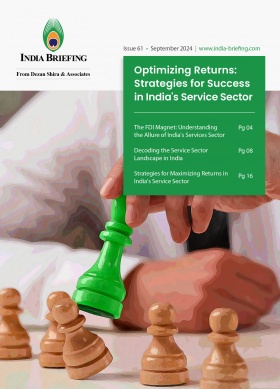India Eyes US$100 Billion Export Target by 2030, Pushes for F&B Sector Investments
India has potential to achieve US$100 billion in combined exports from the food and beverage (F&B), agriculture, and marine products sectors within the next five years, according to the Union Minister of Commerce and Industry. Key industry policies currently facilitate greater foreign investment into the F&B sector – tapping both domestic consumers as well as export-oriented production.
The Union Minister of Commerce and Industry, Piyush Goyal, has expressed optimism towards India achieving US$100 billion trade in combined exports from food and beverage, agriculture, and marine products by 2030. Addressing a stakeholder meeting on January 10, 2024, Goyal underscored the importance of maintaining a consistent growth rate of 14-15 percent across these industries to meet this ambitious target.
FDI in India’s F&B segment
Reiterating central government’s existing food and beverage (F&B) policies, Goyal noted that India allows 100 percent foreign direct investment (FDI) in the F&B sector. This provision permits full foreign ownership and management of businesses, alongside streamlined issuance of work permits for foreign nationals looking to establish or operate businesses in India.
According to the Department of Promotion of Industry and Internal Trade (DPIIT), India’s food processing industry has received US$12,955.90 million of FDI equity inflow from April 2000 to September 2024.
Technological upgradations in India’s F&B sector
The Indian F&B sector is increasingly prioritizing technological advancements, creating significant opportunities for foreign investors to introduce automation, quality control measures, and sustainable practices in food processing. With a growing focus on health-conscious and organic products, the sector aligns with global trends, offering attractive investment prospects in premium and high-value product segments.
The central government is actively encouraging Indian companies to prioritize innovation, improved packaging, and mechanization to enhance hygiene and sustainability standards. This includes the development of nutritionally rich, high-value products that can support government-led food security initiatives.
To address the rising global demand for sustainable practices, India is promoting organic farming and organic food products. Simplified certification processes, combined with measures to uphold integrity and traceability, have been introduced to support the growth of this sector.
Further advancements include plans to expand food testing laboratories across the country. The government has sought input from industry stakeholders on equipment and procedures required to establish state-of-the-art testing facilities. Additionally, manufacturers are being encouraged to explore regional flavors and products to drive innovation and achieve global standards, thereby increasing the international acceptance of Indian F&B offerings.
Is ‘Ready-To-Eat’ India’s new sunrise sector?
According to a research report published in October 2024, India’s Ready-To-Eat (RTE) food market was valued at US$895.64 million in 2024, and is expected to reach US$2.10 billion by 2030, rising at a CAGR of 15.30 percent. RTE food items offer convenience and time savings and are an alternative to food deliveries, thereby allowing consumers to gain access to a variety of quick meal solutions.
According to industry reports, the RTE category includes frozen meals, snacks, instant mixes, and ready-to-cook/pre-prepared/marinated foods. Both domestic and MNC brands are competing to reach more consumers in the Indian market – tapping into trends such as rapid urbanization, evolving consumer lifestyles, and rising disposable incomes. Experience during the pandemic and a rise in healthy diet-oriented food consumption are other factors motivating Indian consumers to explore RTE offerings.
The India RTE food market has experienced significant growth since 2021, driven by evolving consumer lifestyles, increasing urbanization, and a burgeoning middle-class population.
Goyal, acknowledging the success of pre-packaged and RTE Indian foods in global markets, noted that items such as millets, pickles, and spices have gained significant traction abroad. He emphasized the potential of these products to strengthen India’s presence in international markets, while also appealing to a growing domestic demand for convenient food options.
Business advisory for foreign companies entering India’s F&B market
- Leverage India’s growth potential in exports
India aims to achieve a combined export target of US$100 billion in the food, agriculture, and marine sectors by 2030. Foreign companies should align their business strategies to capitalize on this export potential by:
- Partnering with local producers and exporters.
- Leveraging government incentives for export-oriented units.
- Focusing on high-demand global products like organic food, spices, and value-added marine products.
- Maximize benefits of 100 percent FDI policy
India permits 100 percent FDI in the F&B sector, enabling foreign investors to establish wholly owned subsidiaries or joint ventures. To maximize returns:
- Set up fully owned manufacturing or processing units to maintain control over operations.
- Utilize streamlined work permit processes to bring in foreign experts for technical roles.
- Introduce advanced technology and sustainable practices
The Indian F&B industry is embracing technological upgrades to improve efficiency and product quality. Foreign companies can:
- Introduce automation and AI-driven quality control in food processing.
- Promote eco-friendly packaging and sustainable production processes.
- Invest in research and development for innovative, health-conscious, and organic products.
- Capitalize on the Ready-to-Eat boom
India’s RTE market is growing rapidly, with a projected CAGR of 15.30 percent until 2030. Key strategies for entry include:
- Offering frozen meals, instant mixes, and pre-marinated products tailored to Indian tastes.
- Tapping into urban markets with convenient, affordable, and healthy meal solutions.
- Partnering with retail chains and e-commerce platforms to ensure widespread product availability.
- Explore organic and high-value product segments
India’s focus on organic farming presents opportunities in niche segments like organic spices, millets, and superfoods. Foreign investors should:
- Collaborate with certified organic farmers and cooperatives.
- Export premium organic products to meet global demand.
- Ensure traceability and certification standards to build trust and credibility.
- Align with government-led initiatives
The Indian government is promoting food security and export quality through various initiatives. Foreign companies should:
- Participate in food testing and certification programs to meet international standards.
- Align with government programs promoting regional and traditional food products for export.
- Strategic location selection
India’s diverse regions offer distinct advantages in the F&B sector. Foreign companies should consider:
- Setting up units near agricultural hubs to reduce raw material costs.
- Leveraging Special Economic Zones (SEZs) to benefit from tax incentives and superior logistics.
- The regions of Delhi-NCR, Punjab, Haryana, Uttar Pradesh, and Rajasthan – in North India – boast densely populated urban centers with a significant consumer base that prioritizes convenience and ready-to-eat meal options.
- Build strong brand presence with localization
To compete in India’s dynamic market, foreign brands should:
- Adapt products to local taste preferences while maintaining global quality standards.
- Invest in marketing strategies that highlight the convenience, health benefits, and unique features of their offerings.
- Regulatory compliance and supply chain optimization
Understanding India’s regulatory environment is crucial. Foreign companies should:
- Engage with legal and tax advisory services to ensure compliance with BIS, FSSAI, and GST regulations.
- Optimize supply chains to reduce costs and ensure timely delivery of perishable goods.
- Establish relations with existing distribution networks such as retail chains, supermarkets, and hypermarkets. These exhibit regional variations in terms of consumption and spending patterns across the country, necessitating customized sell-to-market strategies.
- Foster industry collaborations
Collaborating with local companies, research institutions, and government bodies can enhance market entry and growth. Foreign firms should:
- Join industry associations to stay updated on market trends and regulatory changes.
- Explore joint ventures for shared expertise and market access.
Summary
By strategically positioning themselves in India’s F&B market, foreign investors can capitalize on the country’s growth trajectory, evolving consumer preferences, and favorable business environment.
About Us
India Briefing is one of five regional publications under the Asia Briefing brand. It is supported by Dezan Shira & Associates, a pan-Asia, multi-disciplinary professional services firm that assists foreign investors throughout Asia, including through offices in Delhi, Mumbai, and Bengaluru in India. Readers may write to india@dezshira.com for support on doing business in India. For a complimentary subscription to India Briefing’s content products, please click here.
Dezan Shira & Associates also maintains offices or has alliance partners assisting foreign investors in China, Hong Kong SAR, Dubai (UAE), Indonesia, Singapore, Vietnam, Philippines, Malaysia, Thailand, Bangladesh, Italy, Germany, the United States, and Australia.
- Previous Article BIS Certification in India: A Brief Primer
- Next Article India’s Trade Landscape Amid Global Geopolitical Shifts: BCG Report Insights








